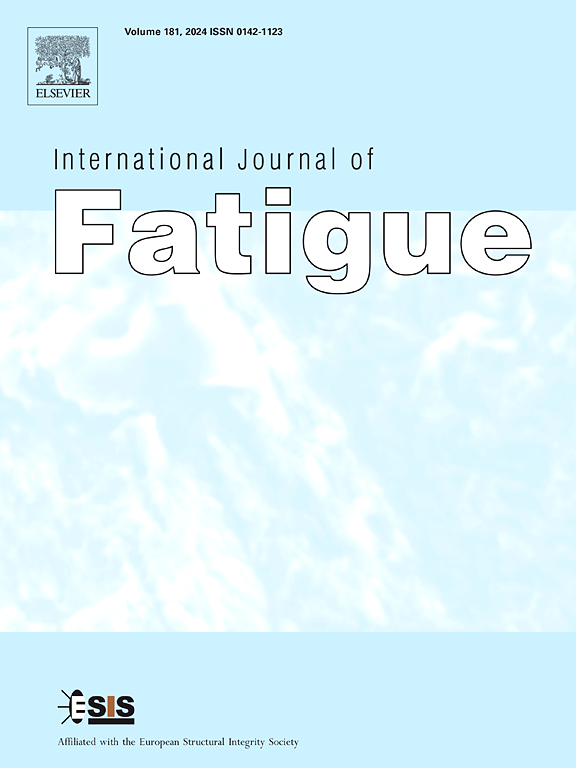损伤深度对激光熔覆修复EA4T钢微动疲劳行为的影响
IF 6.8
2区 材料科学
Q1 ENGINEERING, MECHANICAL
引用次数: 0
摘要
高铁车轴在使用过程中容易受到异物损坏,激光熔覆修复技术可以有效延长其使用寿命。本研究通过熔覆层金相分析、磨损形貌表征和疲劳裂纹扩展观察,探讨了损伤深度对激光熔覆EA4T钢微动疲劳性能的影响。结果表明:熔覆层的主要相为γ-(Ni, Fe)和Cr,晶粒结构沿深度方向由枝晶向等轴晶和柱状晶转变;随着损伤深度的增加(0.5 ~ 2mm),修复试样的疲劳寿命逐渐降低,修复后较早进入裂纹扩展阶段。磨损深度和宽度随循环次数的增加而增加,当循环次数为2 × 105时,最大磨损深度分别为22 μm、42 μm和40 μm。磨损区氧含量随循环次数的增加而显著升高,呈梯度分布:负荷端高于固定端,固定端高于中心区域。本文章由计算机程序翻译,如有差异,请以英文原文为准。

Effects of damage depth on fretting fatigue behavior of EA4T steel repaired by laser cladding
High-speed rail axles are susceptible to foreign object damage in service, and laser cladding repair technology can effectively extend their service life. This study investigates how damage depth affects fretting fatigue performance in laser-clad EA4T steel through metallographic analysis of the cladding layer, wear morphology characterization, and fatigue crack propagation observations. The results show that the primary phases in the cladding layer are γ-(Ni, Fe) and Cr, with a grain structure transitioning from dendritic to equiaxed and columnar crystals along the depth direction. As the damage depth increases (0.5 to 2 mm), the fatigue life of repaired specimens gradually decreases and enters the crack propagation stage earlier post-repair. The wear width and depth increase with the number of cycles, reaching maximum wear depths of 22, 42, and 40 μm with 2 × 105. Oxygen content in the worn zone rises significantly with cycling, exhibiting a gradient distribution: the loading end is higher than the fixed end, which is higher than the central region.
求助全文
通过发布文献求助,成功后即可免费获取论文全文。
去求助
来源期刊

International Journal of Fatigue
工程技术-材料科学:综合
CiteScore
10.70
自引率
21.70%
发文量
619
审稿时长
58 days
期刊介绍:
Typical subjects discussed in International Journal of Fatigue address:
Novel fatigue testing and characterization methods (new kinds of fatigue tests, critical evaluation of existing methods, in situ measurement of fatigue degradation, non-contact field measurements)
Multiaxial fatigue and complex loading effects of materials and structures, exploring state-of-the-art concepts in degradation under cyclic loading
Fatigue in the very high cycle regime, including failure mode transitions from surface to subsurface, effects of surface treatment, processing, and loading conditions
Modeling (including degradation processes and related driving forces, multiscale/multi-resolution methods, computational hierarchical and concurrent methods for coupled component and material responses, novel methods for notch root analysis, fracture mechanics, damage mechanics, crack growth kinetics, life prediction and durability, and prediction of stochastic fatigue behavior reflecting microstructure and service conditions)
Models for early stages of fatigue crack formation and growth that explicitly consider microstructure and relevant materials science aspects
Understanding the influence or manufacturing and processing route on fatigue degradation, and embedding this understanding in more predictive schemes for mitigation and design against fatigue
Prognosis and damage state awareness (including sensors, monitoring, methodology, interactive control, accelerated methods, data interpretation)
Applications of technologies associated with fatigue and their implications for structural integrity and reliability. This includes issues related to design, operation and maintenance, i.e., life cycle engineering
Smart materials and structures that can sense and mitigate fatigue degradation
Fatigue of devices and structures at small scales, including effects of process route and surfaces/interfaces.
 求助内容:
求助内容: 应助结果提醒方式:
应助结果提醒方式:


